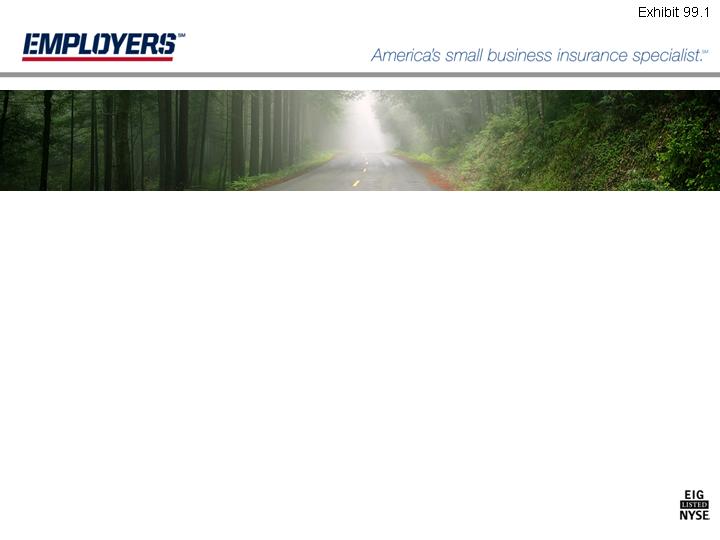
Management Presentation
June 2007

Safe Harbor Disclosure
This slide presentation is for informational purposes only. It should be read in conjunction with our Form 10-K for the year 2006, our Form
10-Q for the first quarter 2007 and our Form 8-Ks filed with the Securities and Exchange Commission (SEC) and available in the “Investor
Relations” section of our website at www.employers.com.
Non-GAAP Financial Measures
In presenting Employers Holdings, Inc.’s (EMPLOYERSSM) results, management has included and discussed certain non-GAAP financial
measures, as defined in Regulation G. Management believes these non-GAAP measures better explain EMPLOYERS results allowing for a
more complete understanding of underlying trends in our business. These measures should not be viewed as a substitute for those
determined in accordance with GAAP. The reconciliation of these measures to their most comparable GAAP financial measures is included
in this presentation or in our Form 10-K for the year 2006, our Form 10-Q for the first quarter 2007 and our Form 8-Ks filed with the
Securities and Exchange Commission (SEC) and available in the “Investor Relations” section of our website at www.employers.com.
Forward-looking Statements
This presentation contains certain forward-looking statements within the meaning of the Private Securities Litigation Reform Act of 1995.
Forward-looking statements include statements regarding anticipated future results and can be identified by the fact that they do not relate
strictly to historical or current facts. They often include words like "believe”, "expect”, "anticipate”, "estimate" and "intend" or future or
conditional verbs such as "will”, "would”, "should”, "could" or "may”. Certain factors that could cause actual results to differ materially from
expected results include increased competitive pressures, changes in the interest rate environment, general economic conditions, and
legislative and regulatory changes that could adversely affect the business of EMPLOYERS and its subsidiaries. All subsequent written and
oral forward-looking statements attributable to us or individuals acting on our behalf are expressly qualified in their entirety by these
cautionary statements. We undertake no obligation to publicly update or revise any forward-looking statements, whether as a result of new
information, future events or otherwise.
EMPLOYERS is a service mark and trade name for a group of companies which provides workers’ compensation insurance and services. Insurance is
offered through Employers Compensation Insurance Company, except in Nevada, where insurance is offered through Employers Insurance Company of
Nevada. Employers Compensation Insurance Company does not do business in all jurisdictions. For more information please visit www.employers.com.
Copyright © 2007 EMPLOYERS. All rights reserved.
1
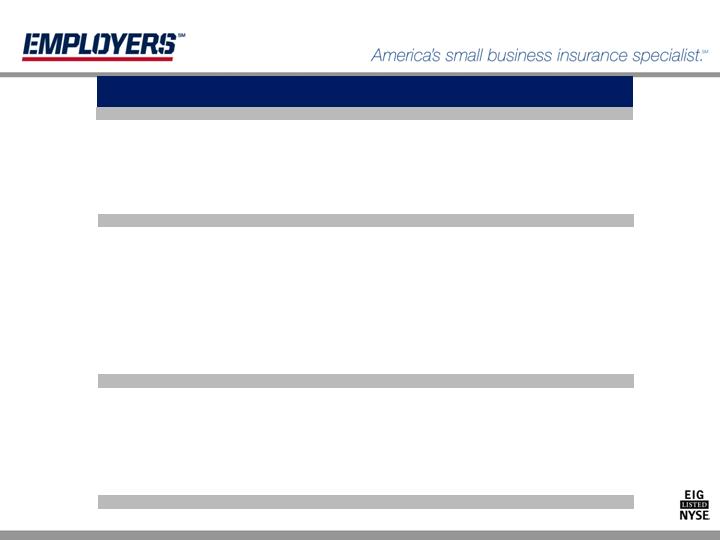
20
California Rate Setting Process
19
California Rates and Rate Setting
14
Customer Selection
21
Insurance Operations Summary
18
Workers’ Compensation Industry
17
Policy Count
16
Strategic Distribution Partners
15
Focused Marketing and Distribution
13
Focus on Low to Medium Hazard Groups
12
Disciplined Underwriting – Five Basic Elements
11
Insurance Operations
6
History
10
Seasoned Executives with Extensive Experience
9
Expanding Geographic Footprint
8
Strategies
7
Financial Snapshot
5
Key Strengths
4
Overview
3
Corporate Overview
2
30
Capital Management
25
Selected Operating Results
31 - 33
SUMMARY
29
Investment Portfolio
28
Reinsurance Program
27
Underwriting Profitability
26
Earnings and EPS
24
Loss Portfolio Transfer
23
Four Key Elements of our Financial Strength
22
Financial Results
Page
Contents

Corporate Overview
3
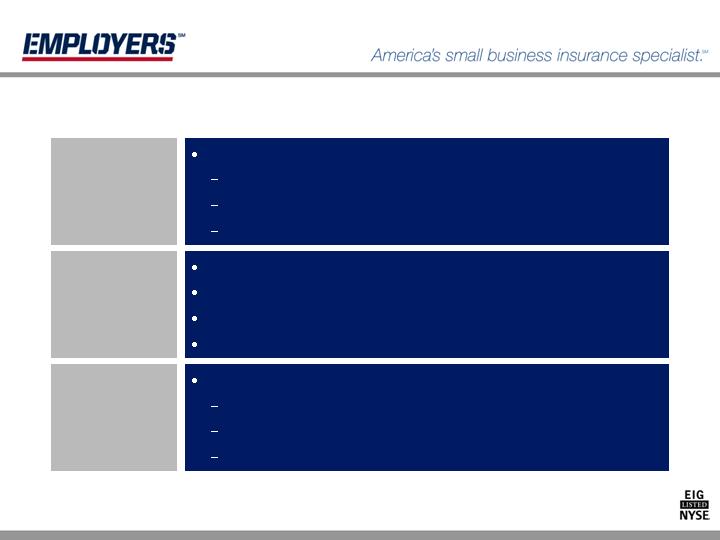
Overview
Business
Specialty provider of workers’ compensation insurance
18th largest private writer in the U.S. (1)
8th largest private writer in California (1)
2nd largest writer in Nevada (1)
Geographic
Focused in Western U.S. – direct premiums written in the first quarter of 2007
66% in California
25% in Nevada
9% in nine other states
Customers
Small businesses in low to medium hazard industries
Distribution through independent agents and strategic partners
30,922 policies in force at 3/31/2007
Average annual policy premium of approximately $11,000
(1) Based on “One-Year Premium and Loss Study,” U.S., California and Nevada, A.M. Best Company, 2006
4

Key Strengths
Established enterprise with 94 year operating history
Focused operations and disciplined underwriting – target an attractive
and underserved market segment with growth opportunities
Unique and long-standing strategic distribution relationships
Financial strength and flexibility - strong balance sheet and conservative
reserving
Experienced management team with deep knowledge of workers’
compensation
5
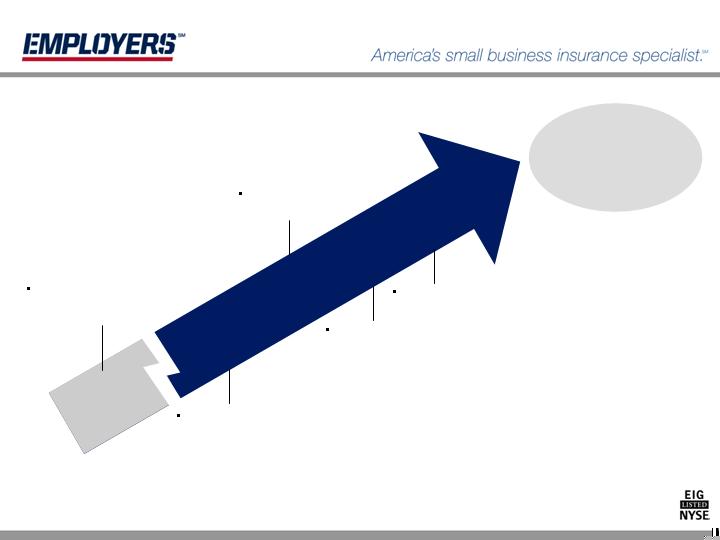
To be the leader in
workers’
compensation for
small businesses
History
(1) EICN = Employers Insurance Company of Nevada; the Fund = Nevada State Workers Compensation Fund
State Workers
Compensation Fund
established in
Nevada
Demutualization
and IPO
Entry into California
Market
Goal:
2000
2007
2002
1913
EICN Assumed Assets,
Liabilities and Operations
of the Fund (1)
2005
6
Conversion to
Mutual Holding
Company
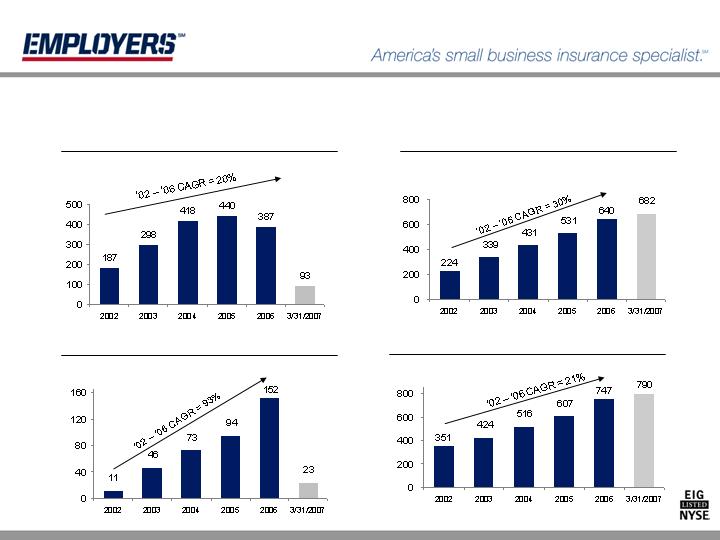
Financial Snapshot
Net Premium Written
Net Income Before Loss Portfolio Transfer (LPT)
Equity Incl. Deferred Gain - LPT
Statutory Surplus
($ million)
Premium growth has reversed due to California rate
decreases
Strong growth provides a solid basis for underwriting
Loss trends and investments are driving net income
Capital management plans include dividends and
share repurchases
7
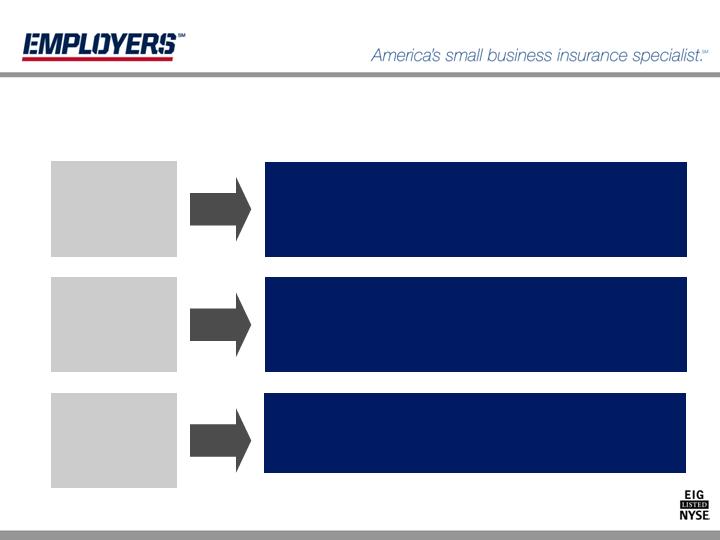
Strategies
Focus on
Profitability
Pursue
Organic
Growth
Opportunities
Optimize
Capital
Structure
8
Consider opportunistic strategic transactions
•
Return capital to shareholders
•
Invest in operations and manage capital prudently
•
Utilize existing and new strategic distribution partners
•
Leverage infrastructure, technology and systems
•
Expand in current markets and in our new states
•
Maintain disciplined risk selection, underwriting and
pricing
•
Target attractive, underserved small business market
•
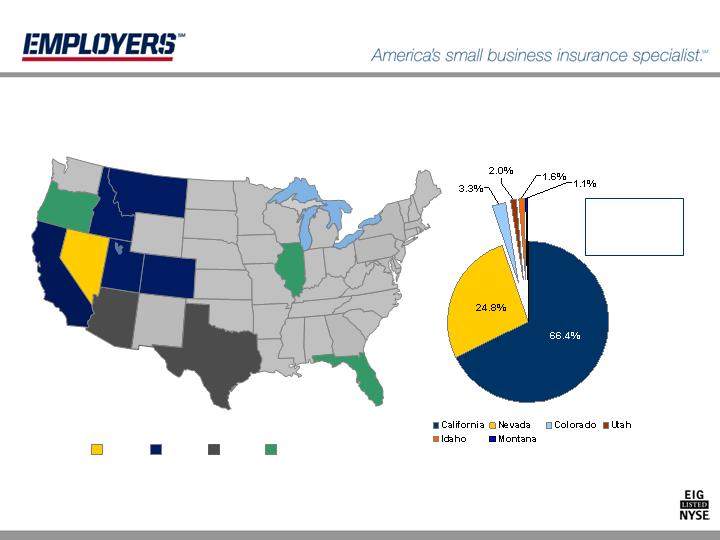
Expanding Geographic Footprint
2000
2002
2006
2007
FL
NM
MD
TX
OK
KS
NE
SD
ND
MT
WY
CO
UT
ID
AZ
NV
WA
CA
OR
KY
ME
NY
PA
MI
NH
MA
CT
VA
WV
OH
IN
IL
NC
TN
SC
AL
AR
LA
MO
IA
MN
WI
GA
MS
VT
NJ
DE
RI
9
NEW STATES
Florida, Oregon,
Texas, Arizona
and Illinois = 0.8%
Direct Premiums Written (%), First Quarter, 2007

Seasoned Executives with Extensive Experience
31
EVP, Chief Financial Officer
William E. Yocke
28
SVP, Chief Underwriting Officer
Jeff J. Gans
25
SVP, Chief Claims Officer
Stephen V. Festa
19
SVP, President of Western Region
George Tway
22
SVP, President of Strategic Markets Region
David M. Quezada
16
SVP, President of Pacific Region
T. Hale Johnston
28
President and Chief Operating Officer
Martin J. Welch
22
Chief Executive Officer
Douglas D. Dirks
Experience
(Years)
Title
Name
Average experience of senior operating leadership = 24 years
10
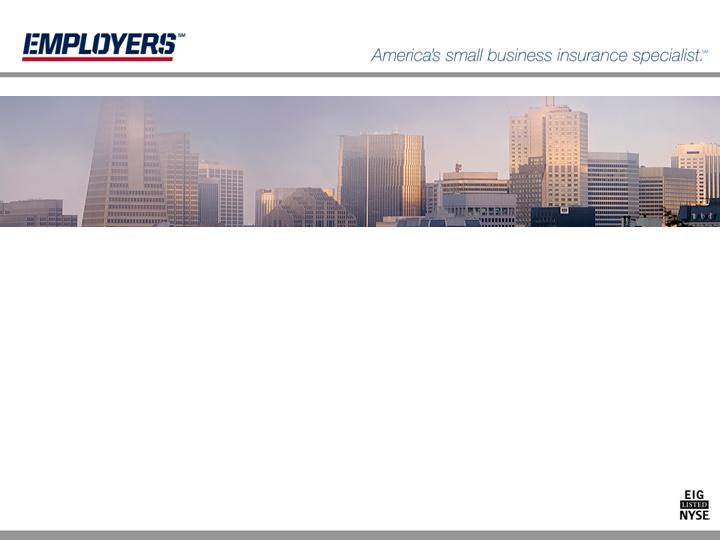
Insurance Operations
11

Disciplined Underwriting
37.9% statutory loss and LAE ratio in 2006
Risk Selection
Expertise
Strong
Underwriting
Culture
Focused
Guidelines and
Consistent
Automated
Approach
Disciplined
Underwriting
Local Knowledge
Pricing of
Individual Risks
Five Basic Elements
12

Focus on Low to Medium Hazard Groups
EMPLOYERS
Focus on low to medium hazard risks allows us to optimize risk selection and pricing adequacy
Hazard Group A
Industry (1)
% of Premiums Written, 12/31/2006
13
Hazard Group B
Hazard Group C
Hazard Group D
Hazard Group E
Hazard Group F
Hazard Group G
Hazard Groups A through D
Lower
Risk
Higher
Risk
(1) NCCI 2006 Premium Distribution by Hazard Group (as presented at 2007 Annual Issues Symposium).
Industry = 56%
EMPLOYERS = 82%
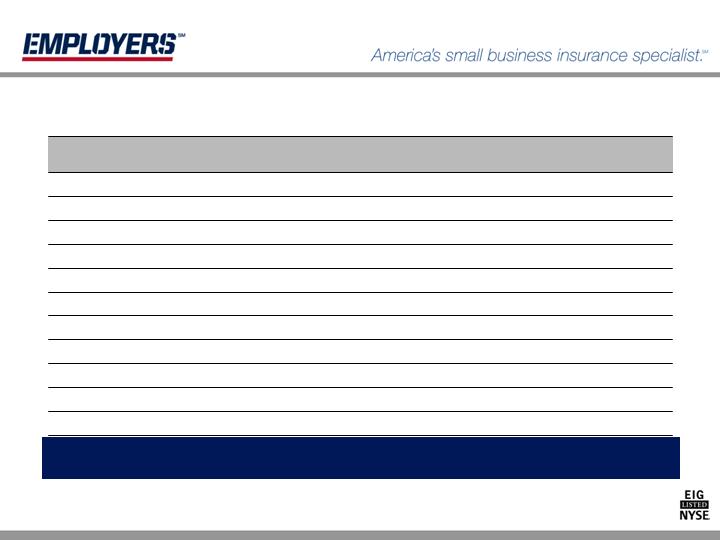
Customer Selection
35.1%
$136,883
Top 10
1.7
6,458
Automobile
D
2.0
7,939
Dentists & Dental Surgeons & Clerical
C
2.3
9,040
Clothing Manufacturers
C
2.4
9,455
Machine Shops
D
2.5
9,846
Clerical Office Employees
C
2.9
11,189
Store: Retail
B
3.0
11,590
College: Professional Employees & Clerical
B
4.8
18,854
Store: Wholesale
B
6.4
24,858
Physicians & Clerical
C
7.1%
$ 27,654
Restaurants
A
Percent of
Total
Direct Premiums
Written (000s)
Class
Hazard
Group
EMPLOYERS further differentiates risks within industry-defined customer classes
Top Ten Classes in 2006
14

Focused Marketing and Distribution
Independent Agents and Brokers
PACIFIC REGION
California
In 2006, 44% of direct
premiums written
STRATEGIC REGION
Largely ADP & Wellpoint;
added E-CHX in Qtr 4, 2006
Primarily California today
In 2006, 30% of direct premiums
written
Three strategic business units target consistent customer segments with a focused
underwriting approach
WESTERN REGION
Nevada, Colorado, Utah,
Montana, Idaho, Texas,
Arizona, Illinois, Oregon,
Florida
In 2006, 26% of direct
premiums written
Strategic Distribution Partners
15
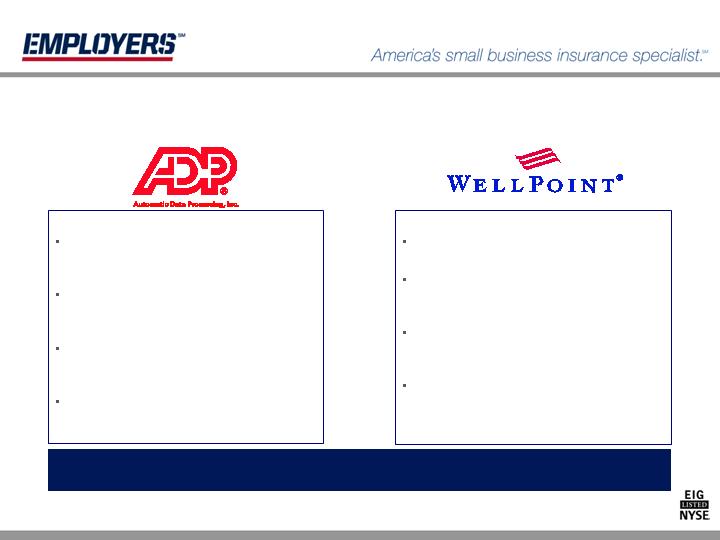
Strategic Distribution Partners
Largest payroll services company in the
U.S. with over 450,000 clients
Partner since entering California market
in 2002
Business originated by ADP’s field sales
staff and insurance agency
“Pay-by-Pay” premium collection
Strategic partners expand market reach and produce business with high persistency
16
Largest group health carrier in California
Partner since entering California market
in 2002
Business originated by Wellpoint’s health
insurance agents
Single bill to customers
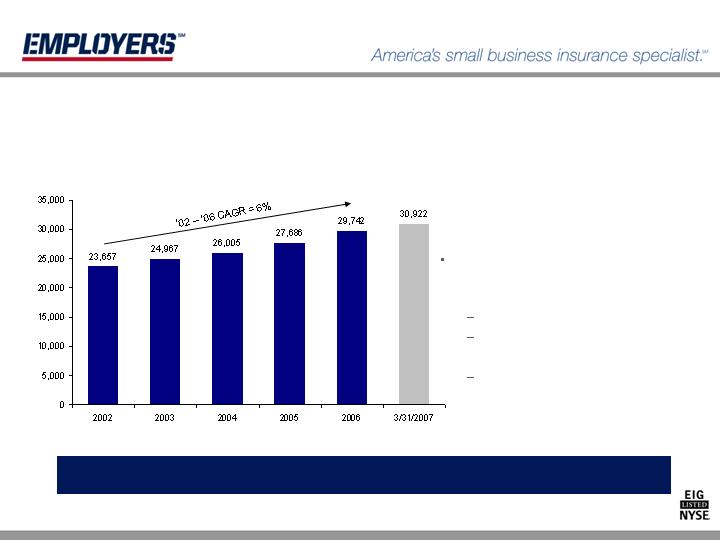
17
17
Solid in force policy count growth
continued in the first quarter, 2007
30,922 at 3/31/2007
27,934 at 3/31/2006
Total increase of 2,988 or
10.7%
In Force Policy Count
17
Total in force policy count has grown consistently with a 2002 – 2006 CAGR of 6%

Workers’ Compensation Industry
Historical Pure Loss Ratio
California
Total U.S.
Source: WCIRB as of 09/30/06 (California); Insurance Information Institute as of 12/31/05 (Total U.S.)
2002: Employers entry
into California
18
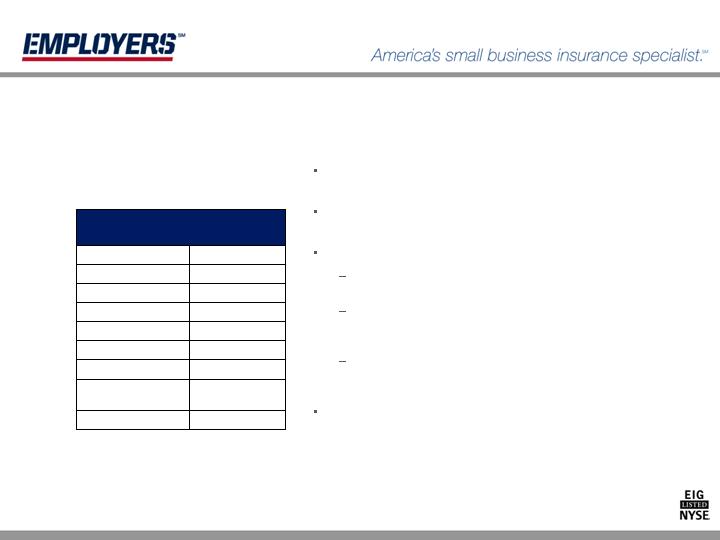
19
California Rates and Rate Setting
-14.2%
Recommended
Effective-July 1, 2007
- 9.5%
January 1, 2007
-65.1%
Cumulative Change
-16.4%
July 1, 2006
-15.3%
January 1, 2006
-18.0%
July 1, 2005
- 2.2%
January 1, 2005
- 7.0%
July 1, 2004
-14.9%
January 1, 2004
Recent Commissioner Approved
Pure Premium Rate Changes
Workers’ Compensation Insurance Rating Bureau
(WCIRB) recommended decrease of 11.3%
Insurance Commissioner recommended decrease of
14.2%
Company’s choice to implement rate changes
Internal analyses are compared to Bureau’s view of the
industry to confirm actual experience
Filed loss cost multipliers (LCMs) account for loss
adjustment, underwriting and commission expenses and
targeted unlevered return of 12% to 13%
Rate deviation plans modify full premium rates based on
individual or group risk characteristics to yield “effective
rates”
At this time, EMPLOYERS will file no change in rates in
California and will continue to evaluate the market
Key Issues
19
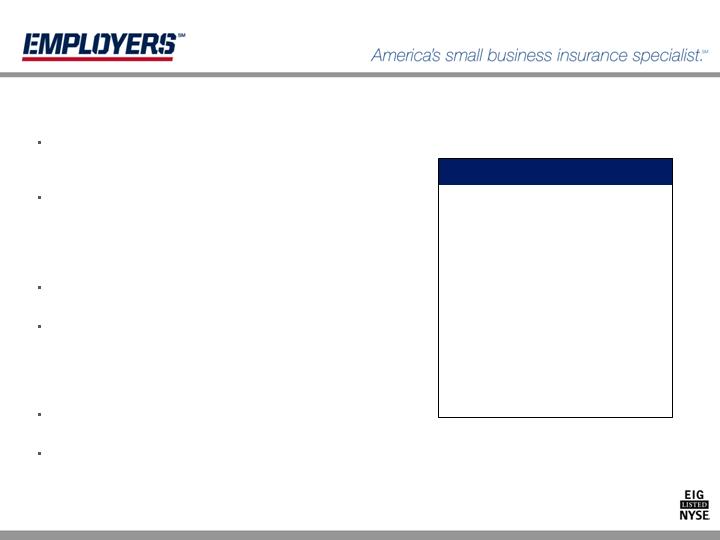
20
California Rate Setting Process
65
Filed Loss Costs Estimate
95
Effective Rates
-5
Schedule Credits
100
Revised Filed Rates
166%
X LCM
60
Revised Loss Costs
Estimate
-7.5%
+ or – adjustment
Rate Setting Process Example
Key Terms: Loss Costs (losses only; also referred to as
pure premium); Lost Cost Multiplier (LCM); Filed Rate;
Schedule Credit/Debit; Effective Rate
WCIRB recommendations to the Commissioner are based
on study of approximately 86% of the industry “ loss
costs”
- Annually by class of business
- Interim studies in aggregate
Commissioner can accept, reject or modify WCIRB
findings
Companies then accept, reject or modify the
Commissioner’s recommendations; if they accept or
modify they file new rates that are the product of revised
pure loss cost estimates X LCM’s required to cover their
total costs by class of business
Companies also file rate deviation plans or schedule
credits
These schedule credits are applied to modify filed rates
to individual policy or group requirements to arrive at
“effective rates”

High performing insurance operation, built upon four key
elements
A highly focused customer base
A disciplined underwriting culture
An efficient -- and scalable – infrastructure
Strong producer and strategic partner relationships, providing us
with:
broader access to markets
enhanced value delivery to our customers
more cost effective production
Insurance Operations Summary
21
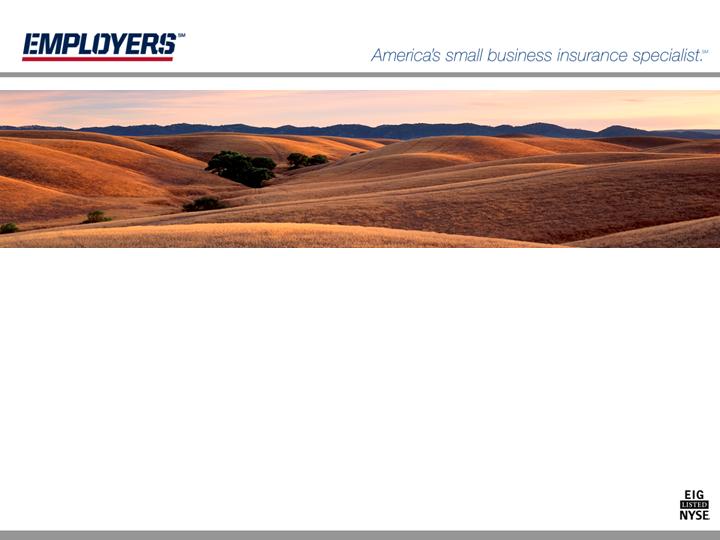
Financial Results
22

Four Key Elements of Our Financial Strength
Surplus of
$640MM
at 12/31/2006
Conservative
Reserving
High Quality
Investment
Portfolio
Catastrophe
Reinsurance
Program
0.6:1 NPW / Surplus
at 12/31/2006
Over 90% fixed maturity
with average rating AA
Coverage up to
$175MM loss
Track record of
reserve strength
23

Loss Portfolio Transfer (LPT)
$ millions
602.5
Gain at 3/31/2007
(147.5)
Subsequent Reserve Adjustments
750
Gain at 1/1/2000
775
Consideration
$1,525
Original Reserves Transferred
$2,000
Total Coverage
Contract
$ millions
438.5
GAAP: Deferred Reinsurance
Gain – LPT Agreement
(164.0)
Cumulative Amortization To Date
$602.5
Statutory Surplus Created
Accounting at 3/31/2007
Non-recurring transaction with no ongoing cash benefits or charges to current operations
Retroactive 100% quota share reinsurance coverage for all losses occurring prior to 7/1/95
Gain on transaction booked as statutory surplus; deferred and amortized under GAAP
24
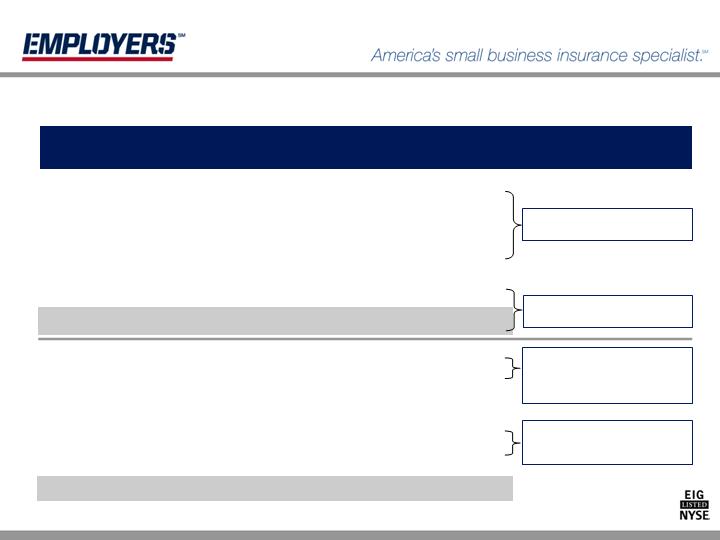
Selected Operating Results
746.8
303.8
2,307.8
3,195.7
80.0
1,715.7
152.2
171.6
68.2
393.0
387.2
$ 401.8
--
--
--
--
--
--
13.4
18.1
15.7
103.3
113.4
$ 117.1
352.0
144.6
Shareholders’ equity
Balance Sheet Data
1,768.6
1,595.8
Total investments
66.5
61.1
Cash and cash equivalents
3,221.2
3,094.2
Total assets
2,307.2
2,350.0
Reserves for loss & LAE
790.4
607.0
Equity including LPT deferred gain
27.9
137.6
Net Income
23.3
93.8
Net Income Before LPT
20.8
54.4
Net Investment Income
89.8
438.3
Net Earned Premium
93.2
439.7
Net Written Premium
$ 96.5
$ 458.7
Gross Written Premium
Income Statement Data
$ million
December 31
2005 2006
First Quarter
2006 2007
Premiums are declining due to
California rate decreases
While premiums have declined in
California, losses have also
declined
Loss trends and investments are
driving net income
Portfolio reallocation (equity sales)
in the fourth quarter of 2006
reduced volatility and increased
investment income
25
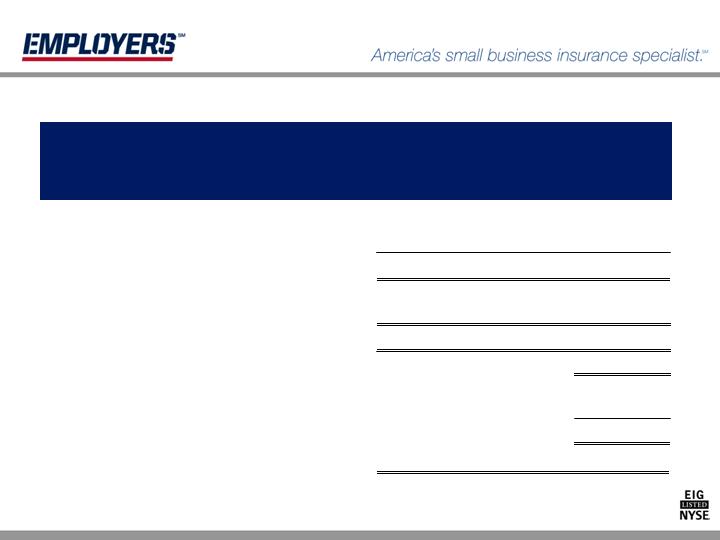
Earnings and EPS
First Quarter
December 31
52,155,944
50,000,002
50,000,002
50,000,002
Weighted Average Shares Outstanding, pro forma (2)
$ .45
$ .27
EPS Before Impacts of the LPT, pro forma (2)
.08
$ .53
N/A
--
--
23.3
(4.6)
$27.9
2007
.40
EPS for the period Feb. 5 through March 31, 2007
--
$3.43
$2.75
GAAP Pro forma EPS – assuming conversion (1)
--
3.04
1.88
EPS (Net Income Before LPT) – assuming conversion (1)
.09
EPS attributable to LPT (2)
$ .36
EPS for three months ended 3/31/2007, pro forma (2)
$18.1
$171.6
$137.6
Net Income
(4.7)
(19.4)
(43.8)
Less: LPT Deferred Gain Amortization
13.4
152.2
93.8
Net Income Before LPT
2006
2006
2005
$ million, except per share data
(1)
Based on 50,000,002 shares assumed outstanding before the conversion.
(2)
Pro forma EPS computed using the actual weighted average shares outstanding as of 3/31/2007. This includes shares outstanding for the period after the Company’s
conversion on 2/5/2007 (53,527,907) and prior to the conversion (50,000,002).
26
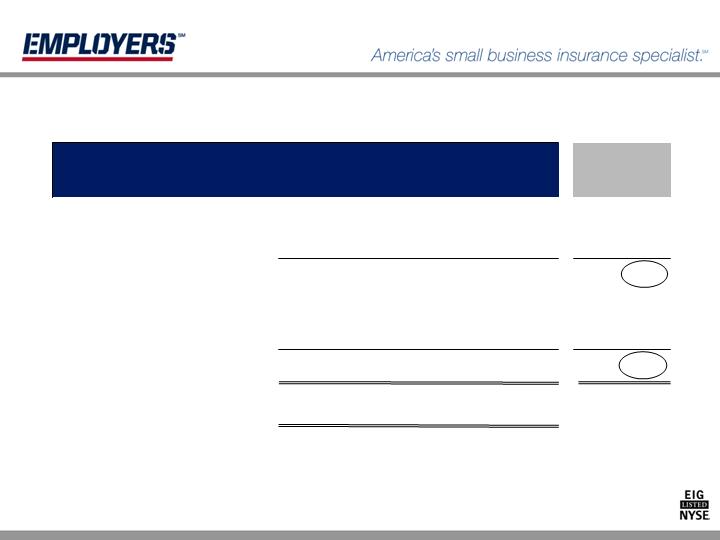
Underwriting Profitability
$6.3
99.3%
18.7%
11.9%
68.7%
4.6%
64.1%
$15.6
$107.1
$78.1
Favorable Reserve Development ($
million)
90.5%
25.9%
13.1%
51.5%
5.1%
46.4%
107.9%
72.6%
84.9%
Combined Ratio (excl. LPT)
25.9%
22.3%
16.0%
Underwriting & Other Expense Ratio (3)
13.1%
12.3%
10.7%
Commission Expense Ratio (3)
68.9%
37.9%
58.3%
Loss & LAE Ratio (excl. LPT)
5.1%
4.9%
10.0%
Less: Impact of LPT (2)
63.8%
33.0%
48.3%
Loss & LAE Ratio
Excluding Qtr. 1,
2007 Reserve
Development (1)
COMBINED RATIO
(GAAP and excluding the LPT)
(1)
Excluding $15.6 million of favorable development, our loss ratio would have been 68.9% and our combined ratio would have been 107.9%. We target a combined
ratio of 100. The total combined ratio includes three items causing upward pressure: (1) one shock loss requiring additional reserves that may run in excess of
$3.5 million; (2) one-time conversion costs of nearly $1 million; and (3) decreasing earned premium.
(2)
Total deferred gain amortization and LPT reserve adjustment of $43.8 million in 2005, $19.4 million in 2006 and $4.6 million in the first quarter of 2007.
(3)
Our higher expense ratio is largely a function of falling California rates.
First Quarter
2006 2007
December 31
2005 2006
27
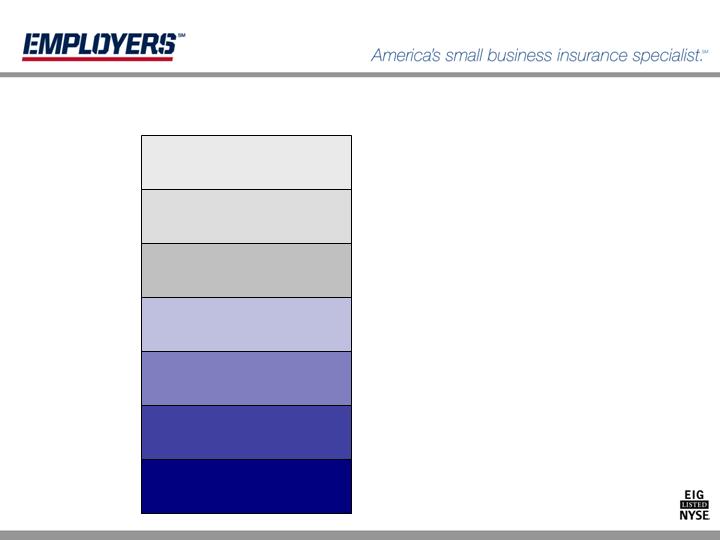
Retention
$10M xs $10M
Catastrophe per Occurrence
First Excess of Loss Layer
$30M xs $20M
Catastrophe per Occurrence
Second Excess of Loss Layer
$50M xs $50M
Catastrophe per Occurrence
Third Excess of Loss Layer
$25M xs $100M
Catastrophe per Occurrence
Fourth Excess of Loss Layer
$50M xs $125M
Catastrophe per Occurrence
Fifth Excess of Loss Layer
$6M xs $4M
First Excess of Loss Layer
$175M
$ 4M
$10M
$20M
$50M
$100M
$125M
Reinsurance Program
28
•
•
•
•
•
•
Catastrophe Excess of Loss includes
maximum any one life of $7.5M
Increased total limits by $50.0M from
previous treaty
Increased retention to $4.0M from
$2.5M from previous treaty
Includes terrorism, except nuclear,
biological, chemical and radiological
Priced annually
Expires 7/1/2007
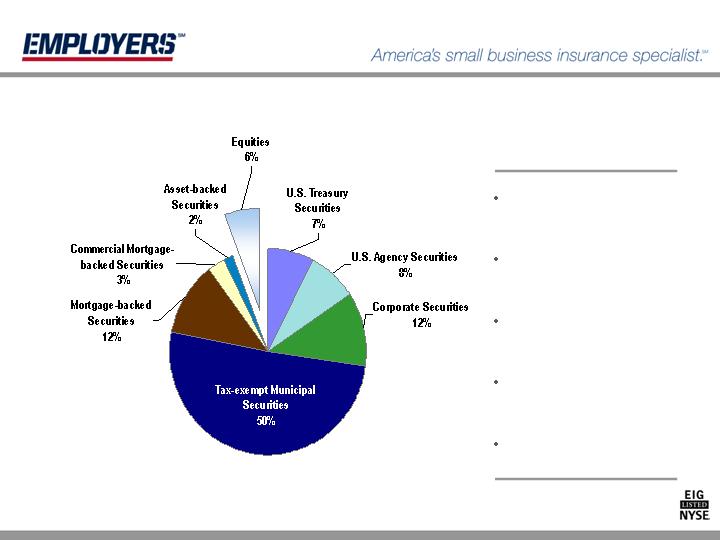
Investment Portfolio
$1.77 billion of
investment securities
Average credit rating of
AA+
Tax equivalent book
yield of 5.3%
Effective duration of
5.73
Outsourced to Conning
Asset Management
Portfolio Mix at 3/31/2007
29
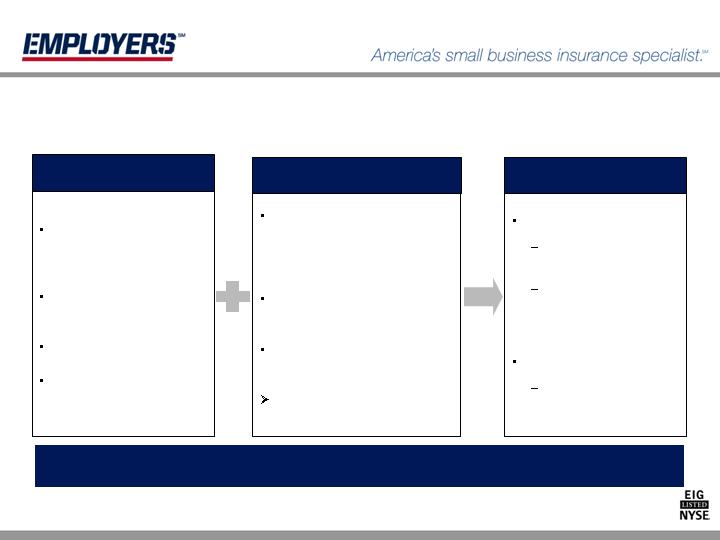
Capital Management
$38 million ordinary
dividend capacity
(unassigned surplus at
12/31/2006), plus
$9.7 million in net proceeds
from the IPO, plus
$55 million approved
extraordinary dividend
Greater than $100 million
available cash in 2007
Holding Company
Cash Flow
Strong Capital Position
$790 million GAAP
adjusted equity at
3/31/2007
0.6:1 NPW/surplus at
12/31/2006
No debt
Reserve strength
Capital Management
Tools
Shareholder dividends
$0.06 per share
quarterly dividend
$3.2 million in
second quarter,
2007
Share repurchases
Up to $75 million in
open market in 2007
Our goal is to drive shareholder value through an improving ROE resulting from (i) profitability
consistent with historical results, (ii) disciplined growth and (iii) prudent capital management
30
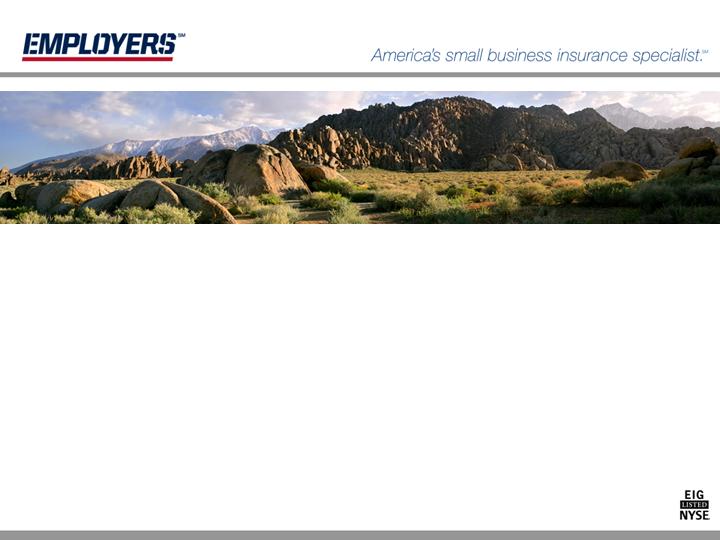
Summary
31
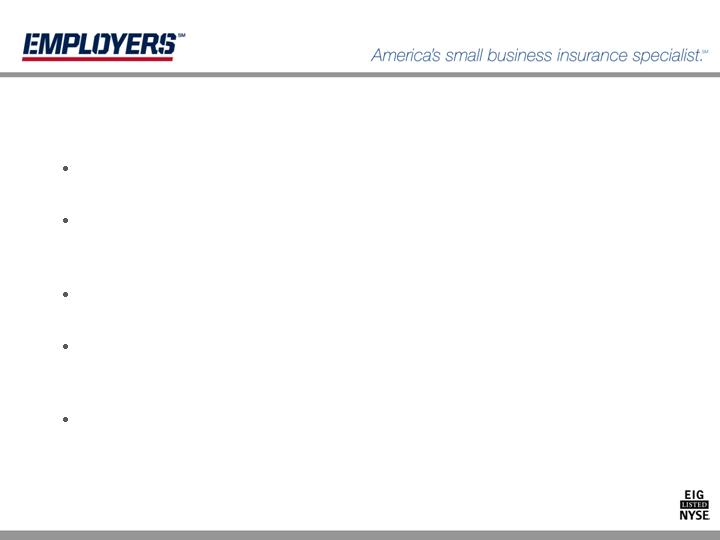
Summary
Established enterprise with 94 year operating history
Focused operations and disciplined underwriting – target an attractive
and underserved market segment with growth opportunities
Unique and long-standing strategic distribution relationships
Financial strength and flexibility - strong balance sheet and conservative
reserving
Experienced management team with deep knowledge of workers’
compensation
32
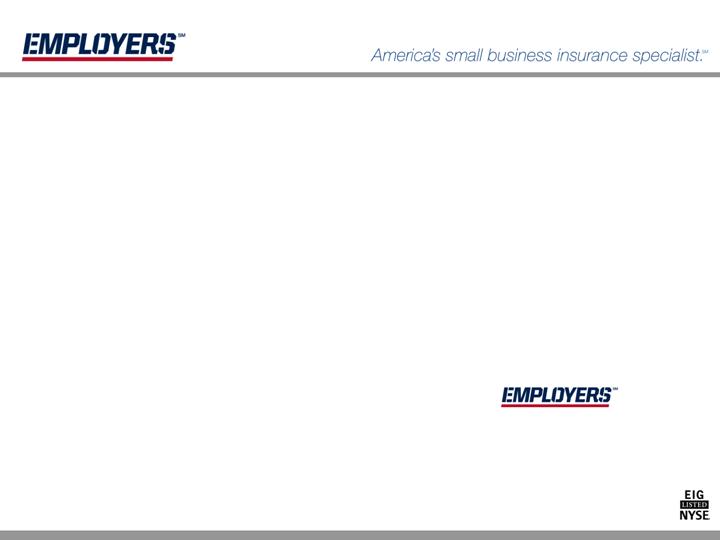
Douglas D. Dirks
President & Chief Executive Officer
Employers Holdings, Inc.
William E. (Ric) Yocke
Chief Financial Officer
Employers Holdings, Inc.
Martin J. Welch
President and Chief Operating Officer
Employers Insurance Company of Nevada and
Employers Compensation Insurance Company
Analyst Contact:
Vicki Erickson
Vice President, Investor Relations
Employers Holdings, Inc.
(775) 327-2794
verickson@employers.com
9790 Gateway Drive
Reno, NV. 89521-5906
(775) 327-2700
33

































